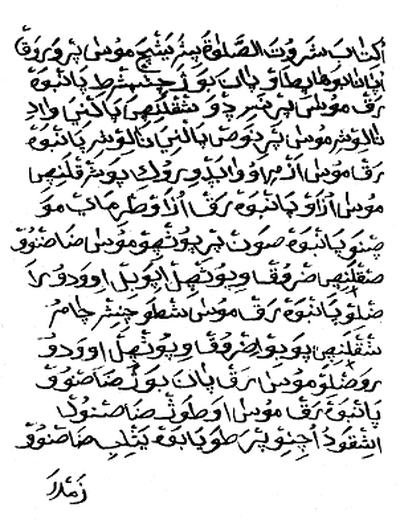Podlachian and West Polesian
The graphic system
Variations discussed here are recorded using the Cyrillic alphabet based on the standard spelling of Belarusian or Ukrainian. The magazine Bielski Hostineć (Бельскі гостінэць) is used based on the Cyrillic alphabet, which uses designations present in the Podlasie pronunciation of diphthongs (vowels with variable course of articulation, such as [e]), as well as the letter Duliczenko 2002 / komentarz/comment/r /
Duliczenko 2002 / komentarz/comment/r / Duličenko, Aleksandr D. 2002. „Westpolesisch”, w: Miloš Okuka (red.) Lexikon der Sprachen des europäischen Ostens. Klagenfurt, s. 581-588. [http://wwwg.uni-klu.ac.at/eeo/]
 ). In 1988, J. Hawryluk, a Ukrainian poet of Podlasie, published his proposal for the spelling of the dialects of Podlasie, based on the Cyrillic alphabet (Hawryluk 1988
). In 1988, J. Hawryluk, a Ukrainian poet of Podlasie, published his proposal for the spelling of the dialects of Podlasie, based on the Cyrillic alphabet (Hawryluk 1988 Hawryluk 1988 / komentarz/comment /
Hawryluk 1988 / komentarz/comment / Hawryluk, Jerzy 1988. Пропозиціï запісу пудляськіх діялєктув. Бельск: Думка.
 ).
).
Example spelling in the journal Bielski Hostineć (after: Fionik i Wrubl'ewski 2006
 Fionik i Wrubl'ewski 2006 / komentarz/comment/r /
Fionik i Wrubl'ewski 2006 / komentarz/comment/r / Фіонік, Дорофʼей & Міколаj Врублʼевскі [Fionik & Wrubl'ewski] 2006. „Дар третʼому поколі͡енʼу”, Biełski Hostineć 4: 4-10.
 ).
).In some publications, the Latin alphabet is used in a variant similar to Polish. The Svoja.org site in particular uses it, and it is also used in publications when the language is specially designed ‘Podlaski’.

Example of the use of the Latin alphabet in orthography based on Polish (https://www.facebook.com/howorymoposwojomu)
Dialects of Southern Podlasie usually do not have a uniform recording system and those that are used are based on Polish.
There are texts in a variety of these varieties (in varying degrees, close to the Polish and Belarusian) recorded using the Arabic script. They were created from the seventeenth to the twentieth century (Antonowicz 1968: 290
 Antonowicz 1968 / komentarz/comment/r /
Antonowicz 1968 / komentarz/comment/r / Антонович А. К. [Antonowicz] 1968. „Краткий обзор белорусских текстов, писанных арабским письмом”, w: В. В. Мартынов, Н. И. Толстой (red.) Полесье (Лингвистика. Археология. Топонимика). Москва: Наука, s. 256-299.
 ; Tołstoj 1968: 17
; Tołstoj 1968: 17 Tołstoj 1968 / komentarz/comment/r /
Tołstoj 1968 / komentarz/comment/r / Толстой Н. И. [Tołstoj] 1968. „О лингвистическом изучении Полесья”, w: В. В. Мартынов, Н. И. Толстой (red.) Полесье (Лингвистика. Археология. Топонимика). Москва: Наука, s. 5-17.
 ).
).
Example text: East Slavic Arabic script. Reproduced Łapicz 1986: 227
 Łapicz 1986 / komentarz/comment/r /
Łapicz 1986 / komentarz/comment/r / Łapicz, Czesław 1986. Kitab Tatarów litewsko-polskich. Toruń: UMK.
 .
.Text notations in many varieties uses primarily the notations of linguistics (phonetic, phonemic), mostly from the Slavic tradition.
ISO Code
no code
in 2011, Jan Maksymiuk applied for a ISO 639-3 code for the Podlachian languages - the application was rejected (SIL 2011 SIL 2011 / komentarz/comment/r /
SIL 2011 / komentarz/comment/r /
SIL 2011. Change request documentation for: 2011-013. [http://www.sil.org/iso639-3/chg_detail.asp?id=2011-013&lang=pdl]
 ).
).
The Ethnologue refers to transitional Belarusian-Ukrainian dialects (Lewis 2009 Lewis 2009 / komentarz/comment/r /
Lewis 2009 / komentarz/comment/r /
Lewis, M. Paul (red.) 2009. The Ethnologue: Languages of the World. Sixteenth edition. Dallas: SIL International. [http://www.ethnologue.com/].
 ).
).
UNESCO Atlas of the World’s Languages in Danger mentions Polesian as a vulnerable language.
The Linguascale encodes all Belarusian-Ukrainian transitional and Polesian varieties with: 53-AAA-edd.
in 2011, Jan Maksymiuk applied for a ISO 639-3 code for the Podlachian languages - the application was rejected (SIL 2011
 SIL 2011 / komentarz/comment/r /
SIL 2011 / komentarz/comment/r / SIL 2011. Change request documentation for: 2011-013. [http://www.sil.org/iso639-3/chg_detail.asp?id=2011-013&lang=pdl]
 ).
). The Ethnologue refers to transitional Belarusian-Ukrainian dialects (Lewis 2009
 Lewis 2009 / komentarz/comment/r /
Lewis 2009 / komentarz/comment/r / Lewis, M. Paul (red.) 2009. The Ethnologue: Languages of the World. Sixteenth edition. Dallas: SIL International. [http://www.ethnologue.com/].
 ).
).UNESCO Atlas of the World’s Languages in Danger mentions Polesian as a vulnerable language.
The Linguascale encodes all Belarusian-Ukrainian transitional and Polesian varieties with: 53-AAA-edd.
- Hawryluk 1988
- SIL 2011
- Lewis 2009
- Czyżewski i Warchoł 1998
- Łesiw 1997
- Wysocki 2005
- Głuszkowska 2001
- Sajewicz 1997
- Duliczenko 2002
- Pazdniakou 2007
- Krywicki 2003
- Hawryluk [?]
- Łesiów 1994
- Maksimiuk 2009
- Michaluk 2010
- Chmielewski 2010
- Kruk 1997
- Mironowicz 2010
- Borciuch i Olejnik 2001
- Antonowicz 1968
- Arkuszyn 2010
- Pawluczuk 1972
- Małecki 2004
- Warchoł 1992
- Smułkowa 2002
- Fionik i Wrubl'ewski 2006
- Tołstoj 1968
- Łapicz 1986
- Klimczuk 2010
- Fałowski 2011
- Fionikowie 2008
- Hlebowicz 2008
- Warchał 1992
- Leończuk 2008
- Stachwiuk 2006
- Kondratiuk 1972
- Sawicka i Wróblewski 1972
- Fionik 2011
- Wiarenicz 2009
- zagrożenie języków / language endangerment
- I.Ignatiuk "Ukraińskie gwary południowego Podlasia
- M.Sarnac'ka - "Pukłunysja swujuj zymli"
- Tablice turystyczne po podlasku i po polsku
- Województwo poleskie w II Rzeczypospolitej
- Mapa Polesia
- Odmiany podlaskie i poleskie
- Gwary zachodniopoleskie na Białorusi
- Przykład ortografii w czasopiśmie Bielski Hostineć
- Użycie alfabetu łacińskiego w ortografii
- Tekst wschodniosłowiański pismem arabskim
- Banner pochodzący z 'Howorymo po swojomu'
- Banner pochodzący z 'Howorymo po swojomu'
- Strona tytułowa podlaskich czytanek dla dzieci
- Tablica w podlaskiej odmianie językowej
- Okładka płyty Піесні спуд Jанова.
- Przejściowe dialekty polsko-białorusko-ukraińskie
- Izoglosy białorusko-ukraińskiej granicy językowej
- Schematyczna granica językowa białorusko-ukraińska